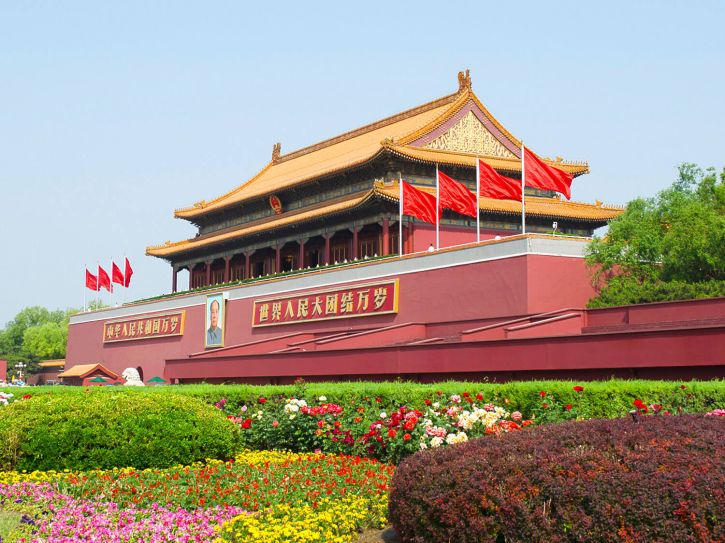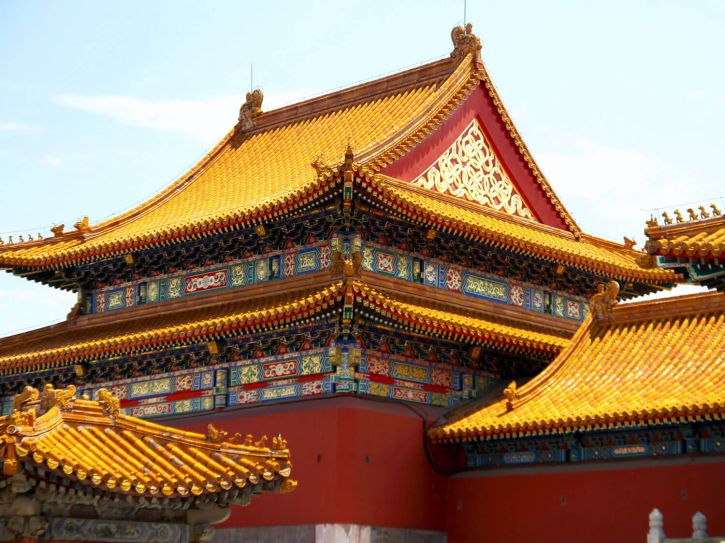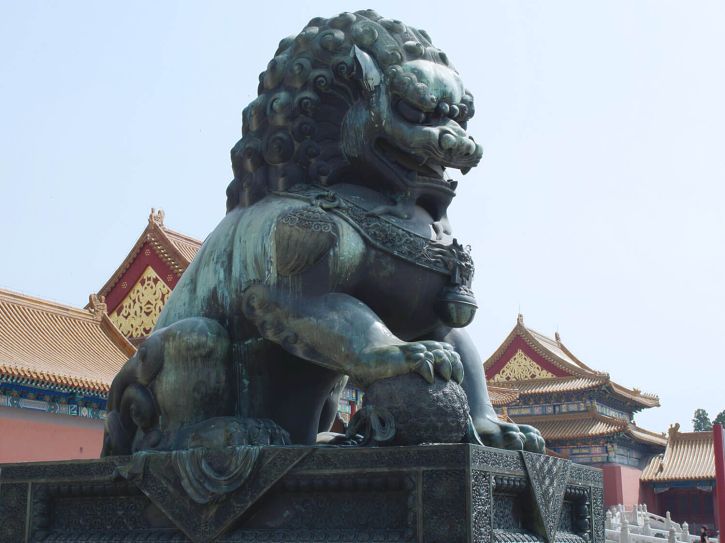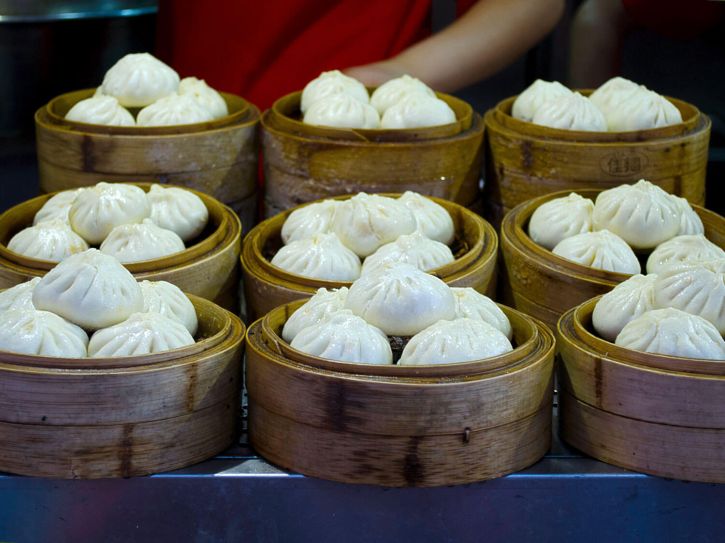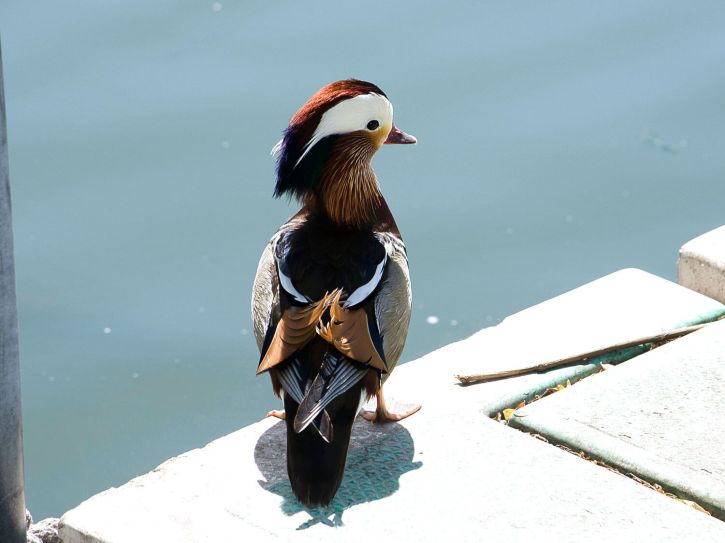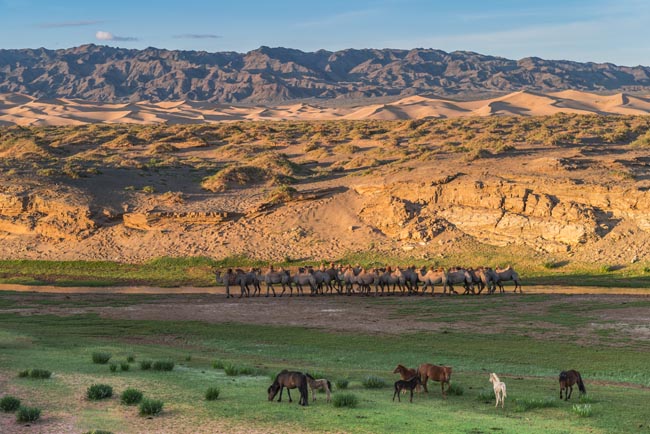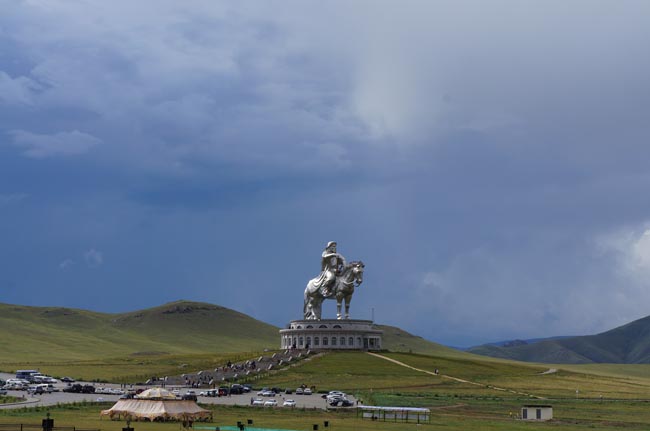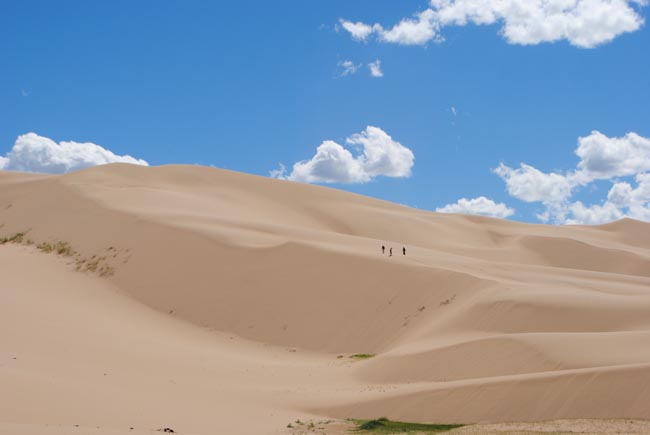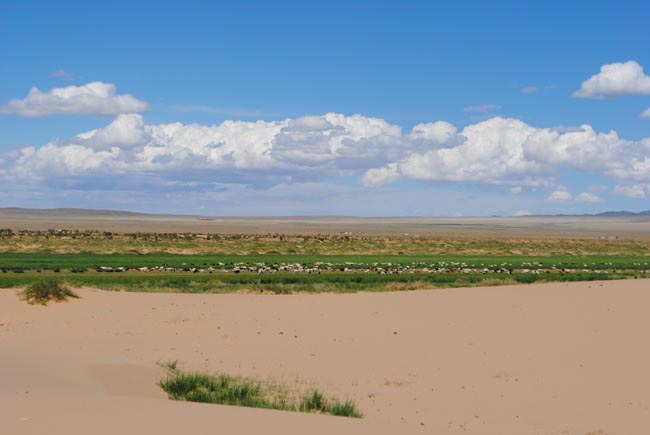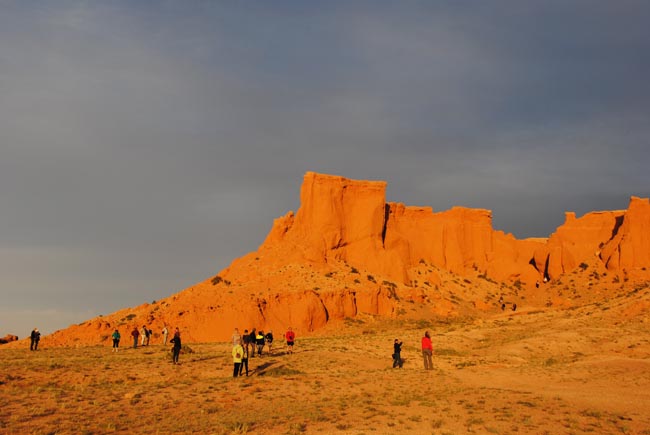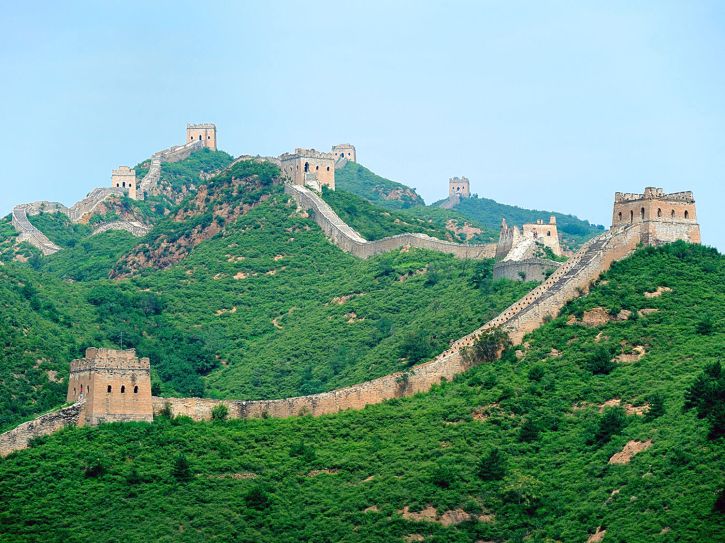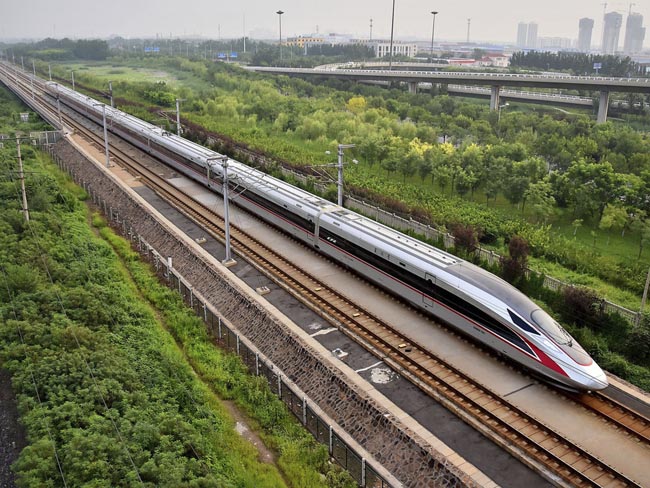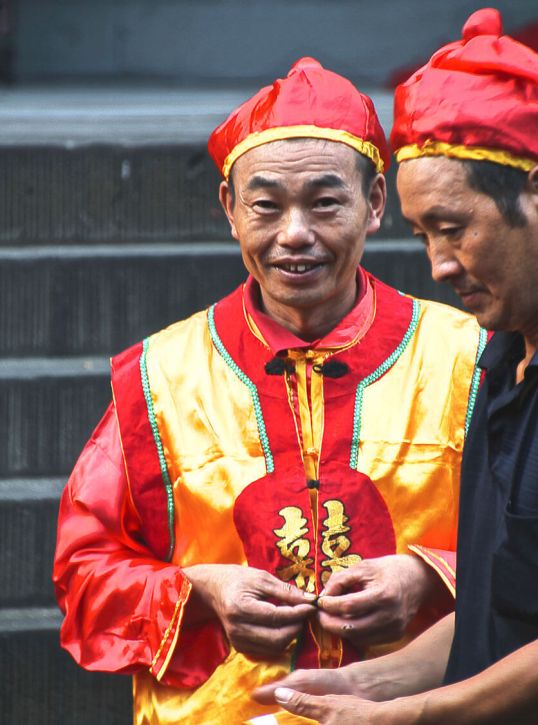This one-time offering was designed by, and will be led by Senior Tour Leader, Jonathan Hodgson. He invites you to join him on the once-in-a- lifetime experience"
"I have the pleasure of introducing a tour spanning two continents on one of the classic rail routes of all time: The Trans-Mongolian Railway! Following in the footsteps of Genghis Khan and his descendants, this tour will begin in Beijing, modern day capital of China, where we will explore nearby Mutianyu, a spectacular and less-visited section of the Great Wall. Our rail journey begins from Beijing and takes us through Datong in Shanxi Province and Inner Mongolia through to the modern nation of Mongolia with its capital, Ulaan Baatar, and nearby ancient Mongol capital of Harhorin. Here you will have the opportunity to experience the Mongol Steppes and the traditional dwelling of the "ger" camp.
We continue to Siberia in Russia, exploring the region of Lake Baikal, old stomping grounds for Genghis and his armies. Heading west, we follow the "classic" Trans-Siberian route, akin to path that the Mongols followed in their sweep across to Europe to dominate the Princes of Rus. We break up our train journey in Yekaterinberg, famed for the city where the Romanov dynasty met its end in the Russian Revolution, and then continue on to Moscow, capital of the Russian Federation."
Download Itinerary
Day 1 Arrival in Beijing, China
We begin our trans-continental rail journey in Beijing, the capital of the People's Republic of China. While many of its elements are common to other Chinese cities, the sum of this city -- its scope and presence in history -- has no equivalent in China or anywhere else in the world.
Beijing is not only the political and administrative center of the People's Republic of China, it is also China's single greatest repository of monuments and treasures from the imperial era. It is also the second-largest and fastest growing municipality in today's China, the home and workplace of over 12 million people.
On and off again capital of a number of Chinese dynasties, Genghis Khan and his Mongol armies razed the city, then known as Zhongdu (or "Central Capital"). His grandson, Kublai Khan, established his Yuan dynasty next to the ruins as the city was rebuilt as the capital under the name "Dadu". Much later, after the fall of the Yuan dynasty and the Ming were overthrown, Beijing became the capital of the Manchus in the 17th century, remaining so excepting the interregnum period between WWI and WWII.
* Please note that we choose to not include the usual sightseeing in Beijing as it is a location that many of our experienced travellers have already visited. If there are those of you interested in spending time in Beijing before the tour begins, please advise at the time of booking.
Overnight in Beijing.
Day 2 Beijing - Great Wall at Mutianyu - Datong
This morning we embark by coach to the Great Wall of China at Mutianyu.
A walk along the enormous undulating towered and turreted wall is spectacular. Rising and falling in concert with the ridges of the northern hills and undulating far off into the distance, the Great Wall consistently exceeds visitors' expectations and remains one of humankind's most remarkable accomplishments.
The wall's construction began during the Warring States Period (403-221 BC), when separate sections were built in scattered strategic areas. Following China's unification under the first Qin Emperor, 300,000 men -- many of them political prisoners whose bodies are buried in the wall -- were put to work connecting the segments into one huge rampart of stone and earth.
Mutianyu is a spectacular section of the Wall that attracts far fewer visitors than the much more popular Badaling section. We will use a cable car to make our way up to the top of the Wall (the more adventurous travellers are welcome to give hiking up to the wall a try – but its difficult!).
Later in the afternoon, we return to Beijing to board our afternoon train to Datong (Inner Mongolia).
We transfer to our Datong hotel upon arrival.
TRAINS: Please refer to the information page for this tour on our website for details pertaining to the nature of the train travel and accommodation on this adventure.
Overnight in Datong.
Day 3 Datong: City Tour
Datong is the gateway to Inner Mongolia and has long been the meeting point for the so-called "barbarians" to the north and the Chinese empires to the south, either in trade or in battle. Now home to approximately 3.5 million, the city and its outskirts has several fascinating points of interest, including the UNESCO Yungang Grottoes, dating back to the 5th century, are home to thousands of Buddhist icons in shallow caves, carved out the Turkic Tuoba peoples. Our visit will include a handful of select caves that highlight this illuminating peek into life on the Silk Road.
Another highlight of the region is our visit to the Hanging Monastery at Mt. Hengshan, dating back some 1600 years and featuring a syncretic blend of Buddhist, Daoist and Confucianist elements.
Our afternoon sightseeing will also include a drive south to Yingxian, site of the wooden Fogong Temple Pagoda, a 67-metre (221 feet) high edifice built by the Emperor Daozong of the Liao Dynasty in 1056AD. Here is the world’s oldest and tallest wooden pagoda, featuring clay Buddha carvings and an 11-metre high statue of Sakyamuni, the present Buddha.
Overnight in Datong.
Day 4 Datong, China - Train to Ulaan Baatar, Mongolia
This morning we transfer to the train station at Datong for our overnight journey to Ulaan Baatar, the capital of Mongolia. We will be clearing Chinese and Mongolian immigration sometime during the night where we will also experience the change of our railway cars from the Chinese (international) gauge of 4' 8.5" wide track to the Russian gauge of 5'. Here, our Chinese train is shunted off to the 'bogie' (wheelset) changing shed for the procedure. You have a choice of staying on the train or getting off to take a closer look at the operation. Once immigration and the gauge procedure is complete, we continue our journey to Ulaan Baatar, passing through the eastern Gobi Desert. Welcome to Mongolia!
Overnight on train.
Day 5 Arrival in Ulaan Baatar, Mongolia
Today we arrive in Ulaan Baatar, the capital of Mongolia, home to a population of over one million people. Literally meaning "Red Hero", Ulaan Baatar has been the capital of the modern Mongolian nation since its inception as a Soviet satellite state in 1924. Now a fast-growing city, as more semi-nomadic herders choose to move here for job opportunities and foreigners come on behalf of multi-nationals seeking access to the rich mineral opportunities available in Mongolia, Ulaan Baatar is surprisingly cosmopolitan with new hotels, restaurants, and shops springing up to meet the new affluence that a market economy brings to the nation. Upon arrival we will transfer to our hotel.
Overnight in Ulaan Baatar.
Day 6 Ulaan Baatar - Ogiy Nuur
We depart the capital for our drive to Arhangai province. Our drive takes us into the heart of the Mongolian steppes, the traditional "highway" that allowed the Mongols an easy means of crossing vast distances of the Asian continent during their time as powerful conquerors in the 13th and 14th centuries. Our overnight destination is the Ogiy Nuur Ger Camp, located by Ogiy Lake, a peaceful and beautiful nature spot.
We spend our first night in a traditional 'ger'.* Gers are the movable domed structures used by nomads for centuries. Made of a latticed wood structure covered with layers of felt and canvas, each ger is heated by a wood stove and furnished with comfortable wood-framed beds. The traditional ger has a lattice-work frame of narrow birch and willow boards held together by leather strips. Traditionally, the "door" consisted of a felt curtain over the door-frame; this is now replaced with a carved or painted wooden door. The entrance of the ger always faces south for orientation and to act as a sun-dial.
Though basic, gers allow us to visit areas that lack travellers' accommodations, and most visitors find their stays at ger camps to be among the most enjoyable experiences in Mongolia. The camps vary in size with most ger tents set up in a double occupancy style that are fully collapsible, and most have shower and WC blocks. Personal water basins for washing are usually provided and water kept topped up. A stove is placed in the middle of each ger and the staff will attend to it in order to provide warmth on cool nights. Towels are provided. Soft drinks, wine and bottled water are all available for purchase from the camps.
* Single gers ARE available on this tour.
Overnight in Ogiy Nuur Ger Camp.
Day 7 Ogiy Nuur - Harhorin - Hogno Khan Uul Reserve
This morning we embark on our full day excursion in this fascinating area. We will drive on the road to Harhorin. We visit Erdenezuu Hiid, a functioning monastery in constant renovation to its former splendour.
This is one of the historically and archeologically richest places in Central Asia. Once, 1000 monks used to inhabit Erdenezuu. Built in 1586, it was constructed from the ruins of the buildings that had once made up the city of Harhorin. The architecture exemplifies the skill of Mongolia's master builders, and is even complete with an ancient freshwater supply system from the nearby Orkhon River. It had some 100 temples within its 400 by 400 meters long walls. The monastery was sacked during the purges of 1937 and only the walls and 3 temples remain. Erdenezuu is still one of the most fascinating sites of Mongolia, and usually we will be able to witness the prayers.
We then continue, enjoying the steppe landscape all the way, and upon reaching the Hogno Khan Uul Nature Reserve we will see Mongol Els sand dunes in the middle of the steppes. They are locally known as "Little Gobi" and next to them there is a very small lake where waders such as herons and ducks may be seen. Transfer from the main road to our ger camp tucked away in a secluded valley at Hogno Khan Mountain.
Overnight in Hogno Khan Ger Camp.
Day 8 Hogno Khan Uul Reserve
Today is free for optional activities.
The Hogno Khan Mountain is a giant rock formation in the middle of the steppes. The small Erdene Khombo monastery, which can be reached by bus or on foot, is now being restored. It was destroyed during the purges of the 1930s. This is an interesting area where many nomadic herdsmen and women live. We can do some day walks into these areas, visit some nomadic families, do some horse riding, or vehicle-supported trips nearby.
Overnight in Hogno Khan Ger Camp.
Day 9 Hogno Khan - Ulaan Baatar
We drive back to the capital.
Overnight in Ulaan Baatar.
Day 10 Ulaan Baatar: Ganden Monastery & City Tour - Overnight Train to Russia
This morning we visit Ganden Monastery, the seat of Buddhism in Mongolia. Most of the temples and monasteries, along with their belongings were destroyed during the Stalinist purges of the late 1930s. Gandantegchinlen Khiid survived because the communists kept it as a showcase to impress foreigners. Roughly meaning 'the great place of complete joy', Gandan is one of Ulanbataar's most amazing sights. Within it are several glorious temples adorned with gold and jewels. The 150 resident monks make the temples lively with plenty of chanting and ceremonies.
After the Monastery we will have a panoramic tour of the capital, including Sukhbaatar Square, the National Museum and the Natural History Museum.
In the late afternoon we may have the opportunity to attend a music performance of Tumen Ekh Folk Song and Dance, that would include a demonstration of traditional Mongolian throat singing.
This evening (after dinner) we depart Ulaan Baatar on the overnight train.
Overnight on Train.
Day 11 Train to Irkutsk, Russia
We continue our train trip north toward the Russian border. After completing Mongolian and Russian immigration procedures* we carry on overnight to our destination of Irkutsk, the so-called "Paris of Siberia". Welcome to Russia!
* Note that the immigration procedures at the Russian border take upwards of 7 hours. However, we are able to rest and relax in our cabins while the officers go about their duties.
Overnight on train.
Day 12 Train - Arrival at Irkutsk - Listvyanka / Lake Baikal
Arrival in Irkutsk (timing is subject to the train schedule from the Mongolian border), one of the tourist centers of Russia situated close by to Lake Baikal.
Irkutsk was founded in 1661 by Cossack troops and became the gate to eastern Siberia and the capital of Siberia at that time. The wonderful historical and architectural monuments in Irkutsk keep the memory of the many events and changes that influenced the economy, culture and politics. Here in Irkutsk, the first Russian revolutionaries, the Decembrists, lived in exile. Nearly all of the centers of the cultural life of the city are situated in ancient buildings of different architectural styles and Irkutsk is often referred to as being a living museum. Very famous here are the ornate old one and two-storied wooden houses, some of which date back to the late 18th century.
We will conduct our sightseeing tour of Irkutsk upon our return to the city after our visit to the Lake Baikal region over the next couple of days. Upon arrival we will transfer by bus to Listvyanka, a community on the shores of Lake Baikal. The small old-style Siberian village, 70km from Irkutsk, is famous for its trade history. This settlement stretches in an arc along the coast at the foot of a high stony ridge. Russian pioneers came to this spot in the middle of the 17th century and a hundred years later there was a stage-post here. The settlement grew along with the development of navigation on Lake Baikal. Listvyanka is now a small settlement but it has shipbuilding and ship-repairing yards of its own.
Overnight in Listvyanka.
Day 13 Listvyanka / Lake Baikal
This morning, we begin our sightseeing tour of Listvyanka and the Lake Baikal region. We will visit the wooden orthodox St. Nicholas Church, which possesses some rare icons dating back to the 18th century. During our visit we hope to be able to taste the cold or hot smoked omul and grayfish, usually offered at the fish bazaar near the harbour. Both of these are a delicacy of Baikal and can be smoked just for you.
Nearby is the Limnological Museum (Baikal Lake Museum), which will introduce us to the origin and wildlife of the lake. This museum is the center for exploration and science of Baikal. The unique exhibits tell us about the origin and the history of the lake, its flora and fauna, geological structure, climate and tectonics of Prebaikalye. One can see exhibits found on different scientific expeditions. Our tour of the museum will also include a 20-minute video titled "The Planet’s Well", with unique shots filmed at the lake's deepest point of 1637 m.
A highlight of our day will be to embark on a private boat tour of Lake Baikal near the Angara River outlet and nearby the Old Railway line (approximately 3 hours).
Overnight in Listvyanka.
Day 14 Listvyanka - Irkutsk
For the Russian people Lake Baikal is a natural treasure. Today, as in the past, this area remains a crossroads of cultures where native Sayats still herd reindeer and Buryat people maintain many of their old traditions. Located in Siberia near the Mongolian border and surrounded by mountains, forests and wild rivers, Baikal is an immense and breathtaking area of physical beauty. Baikal, the deepest lake in the world, holds twenty percent of the earth's fresh water and harbours more endemic species of plants and animals than any other lake in the world. There are a number of islands in the lake, the largest of which is Olkhon, 72 kilometers (45 miles) long. Over three hundred rivers and streams flow into Lake Baikal, of which the six main ones are: Selenga, Chikoy, Khiloh, Uda, Barguzin, and the Upper Angara. Only the Angara River flows out of the lake. The deepest point in Lake Baikal is 1637 m (5371 ft) and the average depth is 630 m (2067 ft).
We check out of our hotel this morning and on our way to Irkutsk, we will visit the Open-Air Museum of Taltsi (the Wooden Architecture Museum), situated near the Angara River. This museum possesses nearly 40 monuments of architectural heritage and 1000's of exhibits of high cultural value. There are two ethnographic complexes, Russian and Buryat, showing the life and traditions of Siberians from the 16th to the 19th century. The most valuable monuments of architecture are the Saviour's gate tower of Ilimsk stockaded town (1667) and the Kazan chapel (1679).
Upon our return to Irkutsk we will have a sightseeing tour, including the Decembrists Museum. Irkutsk is recognized as the Decembrists center of Russia, and Museums have opened in the houses where the families of Sergey Trubetskoy and Sergey Volkonsky lived. Here one can find genuine items that belonged to the Decembrists and replicas of those objects that were lost, such as pieces of furniture, musical instruments, embroidery, books, pictures & photographs in the museums.
Overnight in Irkutsk.
Day 15 Irkutsk - Train to Yekaterinberg: Classic Trans-Siberian Route
Your morning is free to enjoy independent exploration of Irkutsk. We will transfer to the train station for our train, on the classic Trans-Siberian route, from Irkutsk to Yekaterinberg, a journey of approximately 2 days.
What is the Trans Siberian? The Trans-Siberian railway (usually called TransSib in Russia) is the world's longest and the most famous train route that goes through Russia. It crosses the whole continent, starts in Moscow, passes through the European Russia, crosses the Ural Mountains (which separate Europe and Asia), continues into Siberia's taiga and steppes, and finishes in Vladivostok -- the Russian Far East coast on the Pacific Ocean. The Trans-Siberian Route from Moscow to Vladivostok is the original Trans-Siberian Railway.
The Trans-Siberian is an immense route: along more than 9000 kilometers of its length you see different landscapes, meet many different people and cultures, and just enjoy the trip in the train.
Overnight on Train.
Day 16 Trans-Siberian Railway: Classic Trans-Siberian Route
The original Russian name for this railway is "The Great Siberian Way", the name "Trans-Siberian" was given to this route by the West, and soon became very widespread. This railway is the backbone of Russia as it is the only overland route going through the whole country. This unique status makes the railway still quite important for the economy and safety of the country, as it was supposed to be more than 100 years ago, when it was built.
Overnight on Train.
Day 17 Arrival at Yekaterinberg
Today we arrive in Yekaterinberg after our latest train journey of approximately 54 hours. Initially established in Peter the Great’s time to take advantage of its proximity to the Ural mountain minerals, it is most (in) famous for being the location of the murder of Tsar Nicholas II and his family during the Russian Revolution in 1918. It is also known as the city Boris Yeltsin, first president of the newly-fledged Russian Federation, hailed from.
*We may be able to conduct sightseeing on arrival or we may transfer our sightseeing to the next day, dependent on our train schedule.
Overnight in Yekaterinberg.
Included Meal(s): Breakfast and Dinner
Day 18 Yekaterinberg: City Tour - Nevyansk - Yekaterinberg
Today we take a break from our cross-continental journey here to explore the city of Yekaterinberg. We visit the Church Upon the Blood and memorial to the Romanov family. Our tour also includes the Ural Geology Museum, home to over 500 minerals from the Ural Mountains that include some examples of meteorites. Afterwards, we can wander the charming Literary Quarter of the city, home to many restored traditional wooden houses, some of which double as museums.*
In the afternoon we leave on a half-day trip to Nevyansk, north of Yekaterninberg. Site of the Leaning Tower and the Saviour-Transfiguration Cathedral, this small town's fortunes came about due to the industrialist family of the Demidovs, who financed the whole operation during the time of Peter I. Today, these remarkable constructions would not look out of place in any of Russia’s great cities.
We return to Yekaterinberg.
Overnight in Yekaterinberg.
Day 19 Overnight Train to Moscow
This morning we transfer to the train station for our journey to Moscow, capital of the Russian Federation.
Overnight on Train.
Day 20 Moscow: City Tour
This morning we arrive in Moscow, capital of Russia and the largest metropolis in Europe. Over 9 million people call this home and its population lends itself to the charged atmosphere of vibrant urban life. Once a mere trading post during the time of the Princes of Rus, Moscow rose to prominence in the aftermath of the Mongol invasion in 1236, now referred to as the Golden Horde. Thanks to Prince Ivan Danilovich, Moscow grew under the protection of the invaders as the tax collector for the Horde, until it had pre-eminence over the rest of the Russian cities. Finally, under Ivan III (the Great), the Russians won independence from the Mongols in 1480 without a fight. Since then, Moscow has barely looked back, as capital of both Tsarist Russia and as the capital of the USSR, and now of the Russian Federation in post-Communist Europe.
Upon arrival we will meet our guide and coach and begin our sightseeing tour of the city. Today this will include a visit of the Kremlin -- the famous triangular-walled citadel of the Soviet Government dating from the end of the 15th century with its many cathedrals and their iconostases, the bell tower of Ivan the Great; and the Tsar Bell, which weighing 200 tons, is the largest in the world. Upon leaving the Kremlin, be sure to touch the Kremlin Wall -- an omen foretelling your return to this hospitable city. We also include a visit to the Kremlin Armory.
In the afternoon we tour the famous Red Square, once the centre of Soviet life. Around the square is the History Museum, the Tomb of the Unknown Soldier, and the Lenin Mausoleum, built in 1929. In the 16th century, Ivan the Terrible ordered the construction of one of Moscow's most famous landmarks--Saint Basil's Cathedral. Originally called Pokrovsky Sobor (the Cathedral of the Veil), each of the nine cupolas cover a chapel named after the saint on whose feast-day the Russian armies won their battles.
Our city tour will also include brief stops at some of the other nearby monuments of Moscow, including the Cathedral of Christ the Saviour, across the Moscow River from the Kremlin area.
Your evening is free to enjoy on your own time in this remarkable city. You may be interested in attending a performance at the Bolshoi Theatre or the Russian National Dance Show. Your tour leader can help in planning out your free time activities.
Overnight in Moscow.
Day 21 Moscow: City Tour
This morning we will begin with a boat excursion the centre of Moscow. This 90-minute trip gives a great overall sense of Moscow and a great opportunity for photos of this magnificent metropolis.
Our sightseeing today will also include a tour of the Moscow Metro system, in which each station is designed and decorated in a different style, with chandeliers, mosaics, and paintings. Amazingly the underground trains are nearly silent. Some of these stations are so deep that they were used as air raid shelters during WWII.
We will also have an opportunity to explore the pedestrian streets of old Arbat, featuring buskers, painters, and sellers of kitsch Soviet souvenirs. This is a great spot to enjoy a break at a café and pick up any last gifts for friends and family at home. And it’s a great place for people watching!
The rest of the day is free to enjoy Moscow before meeting for our final dinner.
Overnight in Moscow.
Included Meal(s): Breakfast and Dinner
Day 22 Departure
Departure from Moscow.
Included Meal(s): Breakfast
Inclusions
Breakfast and dinner daily and some lunches; other lunches can be purchased a la carte on the trains and elsewhere. All transport, accommodation, sightseeing and entrance fees for sites noted as 'visited' in the detailed itinerary. Gratuities for drivers, restaurant staff, porters (if available). Airport transfers for land & air customers and for early arriving / late departing land & air customers who book their extra hotel nights through us.
Exclusions
International airfare to/from the tour. Tour Leader gratuities, lunches, drinks, personal items (phone, laundry, etc), domestic and international air taxes (if applicable), any excursions referenced as 'optional'. Airport transfers for Land Only customers. Optional trip cancellation insurance and visa fees. Our post-reservation trip notes offer further guidance on optional meal costs, visas, and shopping.
Seasonality and Weather
MOSCOW: Summer sunshine may be nine hours a day with high temperatures from 18-25 C (66-76 F). Rain can be experienced at any time. Autumn can still be warm though mornings and evenings can become chilly. Showers are possible.
MONGOLIA & SIBERIA experiences more extreme weather conditions. Our August / Sept journey will enjoy days that are warm and long but also possibly wet (which brings out the insects). Temperatures from 10-25 C (50-786 F).
Transport and Travel Conditions
ABOUT THE TRAINS: We will attempt to book 1st class cabins (DBL room) for the segments: Datong-Ulaan Baatar, Ulaan Baatar-Irkutsk, and Irkutsk-Yekaterinberg. However, due to the scheduling of trains (and the possibility that train schedules will change without much advance warning), 2nd class cabins may be our only option. For these segments we will book two tickets of 2nd class for each passenger to ensure that there are only 2 travellers per cabin. Limited single cabins available.
Classification of the wagons: Typically, 1st class wagon consists of 9 cabins with two beds in each. Beds are both low and there is a table between them. There is plenty of space to keep your luggage in the compartment, either in an overhead luggage storage area, or under the bed. There are two toilets in each wagon. Second class wagon consists of 9 cabins with four beds in each. Two beds lower and two beds upper and table between them. Two toilets are in the wagon at opposite ends. There are no showers in any of the trains.
IMPORTANT NOTE ON SUITABILITY: YOU MUST BE ABLE TO MANAGE YOUR OWN BAGS ONTO / OFF TRAINS AND IN TRAIN STATIONS. We regret that porters are generally not available and your Tour Leader has very limited ability to assist with baggage. Packing lightly is essential. If you are unsure about your suitability for this type of trip, please call and speak to one of our sales agents for more information.
Am I suitable for this tour? Please refer to our self-assessment form.
Accommodation
Mid-range (3*), well-located, air-conditioned/heated, hotels. All hotels have en suite toilet and bath, though some will have shower only (no tub). Porters may be available (see 'Inclusions'), though you must be prepared to manage your own luggage to and from your hotel room.
Staff and Support
Tour Leader, local guides & drivers.
Group Size
10-16 plus Tour Leader
*The red tour trail on the map does not represent the actual travel path.
The following is a list of sample hotels at some locations included on this tour. The hotels shown here are meant to provide a general sense of the standard of hotel we usually aim for; they are not necessarily confirmed for your chosen departure.








with menus ... wines from around the world.
Located in the heart of Ulaanbaatar city and 100 meters from Sukhbaatar square, Best Western Premier Tuushin Hotel provides excellent proximity to Ulaanbaatar’s major businesses, government organizations, museums, art galleries, concert halls and shopping centers.
